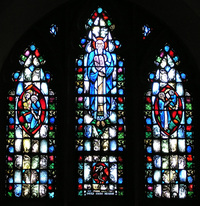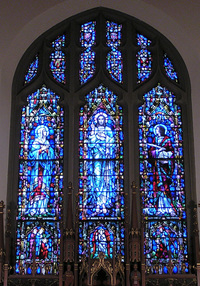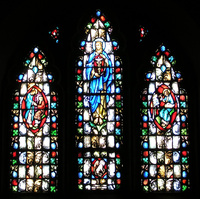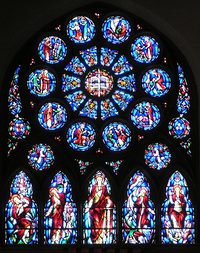MSGC : Featured Windows : Current Window
Featured Windows, August-September 2011
All Saints' Episcopal Church, Pontiac, MI
Building: All Saints Episcopal Church
City: Pontiac
State: Michigan
All Saints’ Episcopal Church. Constructed in the early 1950s.
All Saints’ Episcopal Church traces its beginning to 1837, when the parish was established. Its first wooden church home of 1841 was replaced by a stone church in 1854. After a disastrous fire in 1948 left only the stone walls standing, the church was rebuilt in the original English Gothic style in the early 1950s. Its stained glass windows, installed between 1950 and 1955, were made by Charles J. Connick Associates of Boston, MA. Charles J. Connick (1875-1945) opened his Boston stained glass studio in 1913. Connick and his staff of designers and craftsmen were at the forefront of the revival of the medieval style in stained glass. Their windows featured symbolism in pure color and linear design, and emphasized the relationship between a window's design and its architectural setting, principles set forth in Connick's book, Adventures in Light and Color. Although Connick died in 1945, his studio continued to produce windows in the same medieval style until it closed in 1986.
At All Saints’ Episcopal Church, the great west window portrays the life of St. Paul in its five lower lancets and upper rose. An east window above the altar represents the Resurrection scene. Four three-lancet windows on the north side aisle of the nave depict Moses and three prophets of the Old Testament. Corresponding windows on the south side aisle depict the four Evangelists of the New Testament. Other smaller windows are located in the baptistery and narthex.
St. Paul Window. The life and work of St. Paul are represented in the lancets and rose of this window at the west end of the nave. The central lower lancet depicts the saint holding a sword pointed down, a symbol of his martyrdom. At the left are scenes of his conversion and preaching at Athens; at the right are depictions of his voyage to Rome as a prisoner and his preaching while in Rome. The rose above holds ten circular scenes that portray his acts of healing and preaching. At its center is an open Bible inscribed “Spiritus Gladius” and a sword to symbolize the Word of God as “the sword of the spirit.” Twelve surrounding flames represent the saint’s twelve Epistles.
Resurrection Window. At the center of this three-lancet window above the altar is the figure of Christ, flanked by figures of his mother Mary on the left and his disciple John on the right. In the canopies above and the predella below are various symbols and scenes related to the figures and the Resurrection story.
Moses Window. The central lancet of this window portrays Moses as the lawgiver, holding the tablets of the Ten Commandments. The medallion at the left depicts God’s first call to Moses through a burning bush. The right-hand medallion represents Moses receiving the Ten Commandments from God on Mt. Sinai.
St. Luke Window. St. Luke, one of the four Evangelists, is shown in the central lancet holding a caduceus, symbol of medicine; according to tradition, he was a physician. The medallion at the right depicts him as a painter, another role tradition has assigned to him. In the left medallion, he is shown visiting the imprisoned St. Paul, with whom he traveled on missionary journeys. St. Luke’s symbol, the winged ox, is shown at the bottom of the central lancet.
Martha and Mary Window. Sisters Martha and Mary of Bethany represent two types of Christian service in this upper nave window. At the right, Martha symbolizes a busy life of active work, while Mary at the left represents a quiet life of prayer and meditation. (Luke 10:38-40)
Five Virtues Window. The angelic figures in this narthex window represent five Christian virtues: Truth, Faith, Love, Hope and Justice. The three central biblical virtues of Faith, Love and Hope are mentioned in the New Testament (1 Corinthians 13). At the far left is Truth holding a book; Justice holding a scales is at the far right.
All Saints’ Episcopal Church was registered in the Michigan Stained Glass Census by Brian Goldsworthy of Royal Oak, MI (MSGC 08.0009).
Bibliography:
Show BibliographyAll Saints’ Episcopal Church, Pontiac, MI. http://www.allsaintspontiac.org/
The Charles J. Connick Stained Glass Foundation, Ltd. http://www.cjconnick.org/
Derby, The Rev. Roger S. “A Tour of the Treasures of All Saints.” All Saints’ Episcopal Church, Pontiac, MI. 1992.
The Holy Bible, King James Version. New York: American Bible Society, 1999.
Ferguson, George. Signs and Symbols in Christian Art. New York: Oxford University Press, 1961.(MSGC 2008.0009)
Text by Betty MacDowell, Michigan Stained Glass Census, August , 2011.








